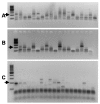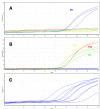PCR-based detection of Plasmodium in Anopheles mosquitoes: a comparison of a new high-throughput assay with existing methods
- PMID: 18793416
- PMCID: PMC2553798
- DOI: 10.1186/1475-2875-7-177
PCR-based detection of Plasmodium in Anopheles mosquitoes: a comparison of a new high-throughput assay with existing methods
Abstract
Background: Detection of the four malaria-causing Plasmodium species (Plasmodium falciparum, Plasmodium vivax, Plasmodium ovale and Plasmodium malariae) within their mosquito hosts is an essential component of vector control programmes. Several PCR protocols have been developed for this purpose. Many of these methods, while sensitive, require multiple PCR reactions to detect and discriminate all four Plasmodium species. In this study a new high-throughput assay was developed and compared with three previously described PCR techniques.
Methods: A new assay based on TaqMan SNP genotyping was developed to detect all four Plasmodium species and discriminate P. falciparum from P. vivax, P. ovale and P. malariae. The sensitivity and the specificity of the new assay was compared to three alternative PCR approaches and to microscopic dissection of salivary glands in a blind trial of 96 single insect samples that included artificially infected Anopheles stephensi mosquitoes. The performance of the assays was then compared using more than 450 field-collected specimens that had been stored on silica gel, in ethanol or in isopropanol.
Results: The TaqMan assay was found to be highly specific when using Plasmodium genomic DNA as template. Tests of analytical sensitivity and the results of the blind trial showed the TaqMan assay to be the most sensitive of the four methods followed by the 'gold standard' nested PCR approach and the results generated using these two methods were in good concordance. The sensitivity of the other two methods and their agreement with the nested PCR and TaqMan approaches varied considerably. In trials using field collected specimens two of the methods (including the nested protocol) showed a high degree of non-specific amplification when using DNA derived from mosquitoes stored in ethanol or isopropanol. The TaqMan method appeared unaffected when using the same samples.
Conclusion: This study describes a new high-throughput TaqMan assay that very effectively detects the four Plasmodium species that cause malaria in humans and discriminates the most deadly species, P. falciparum, from the others. This method is at least as sensitive and specific as the gold standard nested PCR approach and because it has no requirement for post-PCR processing is cheaper, simpler and more rapid to run. In addition this method is not inhibited by the storage of mosquito specimens by drying or in ethanol or isopropanol.
Figures




References
-
- Burkot TR, Williams JL, Schneider I. Identification of Plasmodium falciparum-infected mosquitoes by a double antibody enzyme-linked immunosorbent assay. Am J Trop Med Hyg. 1984;33:783–788. - PubMed
-
- Fontenille D, Meunier JY, Nkondjio CA, Tchuinkam T. Use of circumsporozoite protein enzyme-linked immunosorbent assay compared with microscopic examination of salivary glands for calculation of malaria infectivity rates in mosquitoes (Diptera : culicidae) from Cameroon. J Med Entomol. 2001;38:451–454. - PubMed
Publication types
MeSH terms
Substances
Grants and funding
LinkOut - more resources
Full Text Sources
Molecular Biology Databases

